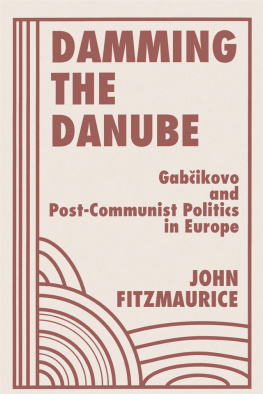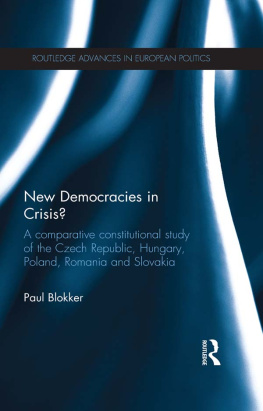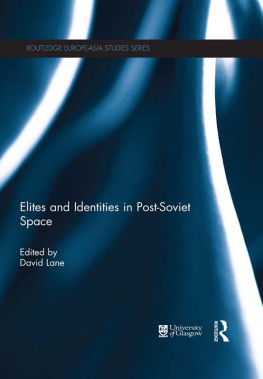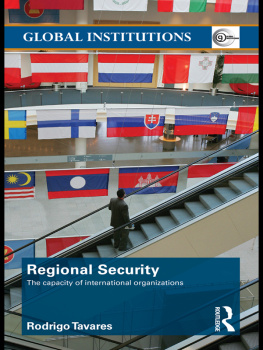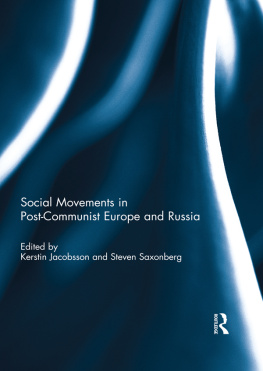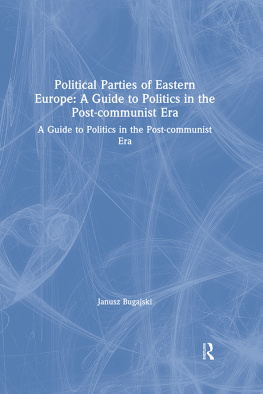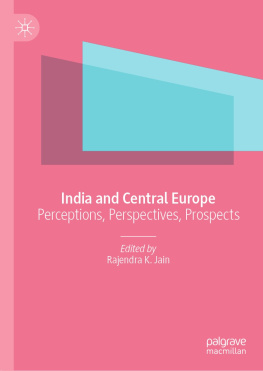Damming the Danube
Damming the Danube
Gabikovo and Post-Communist Politics in Europe
John Fitzmaurice
For G.P.
First published 1998 by Westview Press
Published 2018 by Routledge
711 Third Avenue, New York, NY 10017, USA
2 Park Square, Milton Park, Abingdon, Oxon OX14 4RN
Routledge is an imprint of the Taylor & Francis Group, an informa business
Copyright 1998 Taylor & Francis
All rights reserved. No part of this book may be reprinted or reproduced or utilised in any form or by any electronic, mechanical, or other means, now known or hereafter invented, including photocopying and recording, or in any information storage or retrieval system, without permission in writing from the publishers.
Notice:
Product or corporate names may be trademarks or registered trademarks, and are used only for identification and explanation without intent to infringe.
Library of Congress Cataloging-in-Publication Data
Fitzmaurice, John.
Damming the Danube: Gabcikovo and post-communist politics in Europe / by John
Fitzmaurice.
p. cm.
Includes bibliographical references and index.
ISBN 0-8133-3628-7
1. Water resources developmentPolitical aspectsDanube River
Region. 2. Water resources developmentSocial aspectsDanube
River Region. 3. HungaryForeign relationsSlovakia.
4. SlovakiaForeign relationsHungary. 5. Political stabilityDanube
River Region. 6. EuropePolitics and government1989
7. Gabcikovo (Power Plant) I. Title.
HD1697.5.D358F57 1996
333.91'009496dc20 96-11288
CIP
ISBN 13: 978-0-8133-3628-2 (pbk)
I owe a debt of gratitude to the very many people who helped me freely and with great enthusiasm on this project. First, I must mention President Arpd Gnsz, President of Hungary, who did me the honour of receiving me and expressing his support for the project. I should also like to thank State Secretary Tatar, Members of Parliament from all the major Hungarian political parties, Mr. Janos Vargha of the Danube Circle, Professors Valki and Nagy of the ELTE University and Hungarian legal team for giving me their time and expertise.
In Slovakia, I owe a particular debt to then Foreign Minister Kuan and former Minister Hofbauer, Deputy Speaker Proks, Dr. Binder, Director of Vodohospodarska Vystaba and Mr. Lika, also of Vodohospodariska Vystaba, who took me to visit the site and initiated me into its complexities. Nor should I forget Mr. Vrsansky, Head of the Legal Department of the Foreign Office, now representing Slovakia in the Hague or Mr. Ambassador Chmel, Czechoslovak Ambassador in Budapest until April 1, 1993. I must mention Mr. Hrasko, Minister of the Environment in the Moravik government.
In Vienna, Mrs. Radzyner of ORF, Mr. Fuak of the APA agency and Mr. Meister of the Bundes Umweltamt were guides to the "Austrian Connection" angle.
My thanks are also due to Mr. Michael Leigh of the EC Commission in Brussels.
Very special thanks are due to Tamas Kende of the International Law Department of the ELTE University in Budapest for so expertly organising my meetings in Hungary. Without his help, this book would not have been possible. I should also like to thank Mrs. Kovaova of the Press Department of the Slovak Foreign Ministry for skilfully arranging meetings in Bratislava.
Once again, Ms. Anna Isaac has expertly transformed my hieroglyphics into a tidy manuscript, coping with many difficult words in Slovak and Hungarian with patience and professionalism. Nor would I wish to forget Susan McEachern, Senior Editor of Westview for her enthusiastic support for this project and her hard work in bringing it to fruition.
Last, let me state clearly that responsibility for any errors are mine, as are the views expressed and conclusions reached, though I have tried to let all the various contending views on this controversial issue find fair expression. This is more than the usual disclaimer on an issue which is such a political, scientific and legal minefield.
John Fitzmaurice
The Nagymaros-Gabikovo project for a dam on the Danube River on the Hungarian Slovak border is a powerful and potentially explosive symbol, but a symbol with many readings.
For those who promoted the project, essentially the former communist regimes in Czechoslovakia and Hungary and parts of the Austrian banking and energy utility establishment, it was a symbol of progress, economic independence, control over nature, national pride and prestige. For its opponents, Greens and central European dissidents, it was a symbol of everything that was wrong with the communist system in Central Europe: a prestige project that would violate the Danube River, destroy the environment and traditional ways of life; a project that no longer had--if it ever did--an adequate economic justification to counterbalance the environmental damage. Politically, it was an example of the stubborn conservatism and stagnation of old style communist leaders and their refusal to adapt and respond to increasingly critical voices in society. It was, too, an example of the paradoxical collusion of Conservative Communists and western financial interests so characteristic of the 1970s and 1980s. It was a collusion that sought to defend the status quo, east and west.
The aim of this book will be to explore the complex ramifications of this massive project. We shall seek to explore and understand how the project came into being. We shall look at its purpose, its intended economic advantages. We shall seek to set the project in the political context of the region. History is for good or ill a real and living thing in Central Europe. Present events that seem obscure often can only be understood against the background of historical events in the region. Ancient hatreds and suspicions are often only just below the surface, waiting to re-emerge. The seismic events of 1989 saw the collapse of communism which had been a restraining influence on nationalism in Central Europe.
The Dam is not just a dam. It is a symbol. That is the key to understanding why the issue has aroused such strong feelings on both sides and why it could easily become a source of regional conflict and instability.
This book is about the politics of the dam. It is not an ecological or economic analysis of the pros and cons of this controversial project. But, we shall need to present the complex economic and environmental arguments deployed by both sides in their unrelenting battle for public opinion at home and even more abroad. The author feels like a Hungarian politician, who recently expressed his exasperation with experts on the dam. He said that he believed them all at one time or another. The author has tried to present these arguments in as balanced and objective fashion as possible and always seeking to provide counter-arguments to any arguments.
The dam, the conflict that it has engendered and its wide political, legal, environmental and economic ramifications are important as a paradigm of modern Central Europe.
J.F
- 1880 First proposals for a hydroelectric dam on the Danube
- 1920 Trianon Treaty fixes the Danube as the border between Hungary and Slovakia
- 1952 First talks between Hungary and Czechoslovakia on a dam project
- 1954 Serious floods in Hungary
- 1954 Hungarian Water Management Plan recommends a jointlyconstructed power dam

